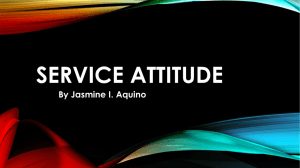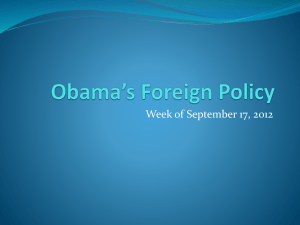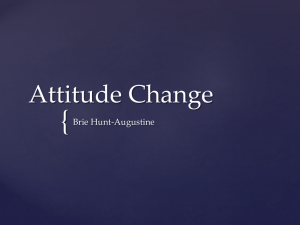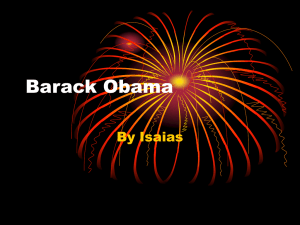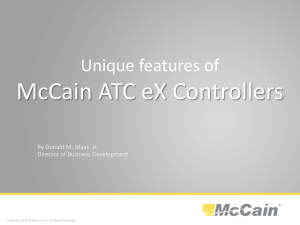Berger & Fitzsimons – Pen Color Study
advertisement
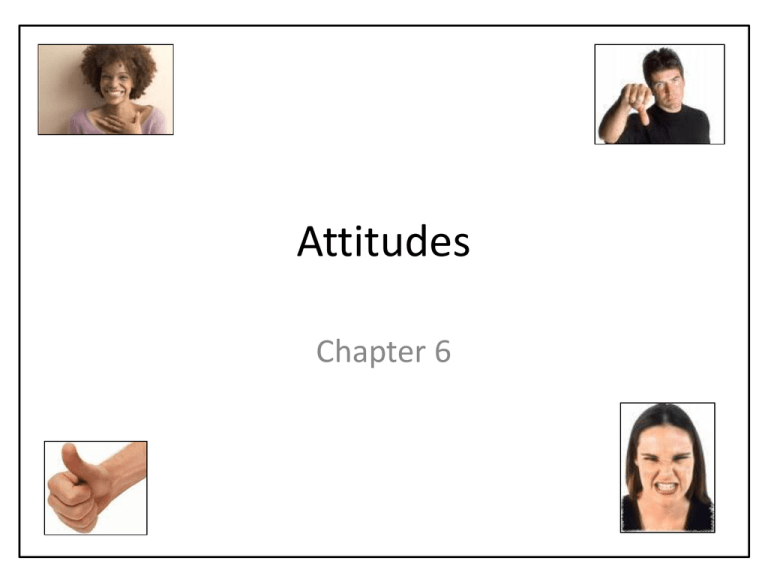
Attitudes Chapter 6 Gordon Allport On the Importance of Attitudes The attitude is the most distinctive and indispensable concept in contemporary American social psychology. Defining Attitudes Definition “Positive or negative evaluation of an object” (e.g., person, activity, group, object). Psychological tendency that is expressed by evaluating a particular entity with some degree of favor or disfavor. (Eagly & Chaiken, 1998) Elements of Attitudes (tripartite view) Cognition (beliefs) Evaluation (like vs. dislike) Behavioral predisposition Contemporary View Attitudes are positive or negative (affective) evaluations of an attitude object Seattle Las Vegas Cougars Huskies Attitude Models Fishbein and Ajzen’s Theory of Reasoned Action Attitude toward Behavior (or Object) Σ = add up the (b x e) products n AB biei n = # of attributes i 1 AB = Overall attitude toward behavior ei = evaluation of behavior on attribute i bi = Strength of belief that behavior has attribute i This consumer would prefer 7UP to Diet Pepsi Subjective Norm Σ = add up (NB x MC) products m SNB NB j MC j m = # of people j 1 SNB = Subjective Norm regarding behavior MC = motivation to comply to person j NBj = Normative Belief of person j Theory of Planned Behavior: When Do Attitudes Guide Behavior? Perceived Behavioral Control Attitude Subjective Norms Intention Behavior Problems: • Doesn’t explain spontaneous or habit driven behavior very well. • May be better to think of BC as a moderator of att-intention relationship Apply the TPB To Exercise Attitude Formation Mere Exposure Classical Conditioning Reward and Punishment Direct and Observational Learning Self-Perception When attitude is weak Face, Head, and Body Movements… Attitudes Formed to Serve Various Functions Utilitarian (rewards, approval) Knowledge (make sense of world) Ego Defense (self-protection) Value Expression Pavlov Classical Conditioning UCS UCR + CR CS Do Attitudes Predict Behavior? Alan Wicker’s (1969) Conclusion It is considerably more likely that attitudes will be unrelated or only slightly related to overt behaviors than that attitudes will be closely related to actions. It may be desirable to abandon the attitude construct. A Puzzling Finding: La Piere’s (1934) Study Traveled with Chinese couple in early 30’s Visited > 250 restaurants & hotels Follow-Up Questionnaire 90 % of owners said wouldn’t let Chinese in but, only 1 actually refused Highlights weak att-beh relationship When Do Attitudes Guide Behavior? A & B “match” in specificity A & B measured close in time A linked with intention to act A based on direct experience High Ego Involvement & Vested Interest Low Self-Monitors High Private Self-Awareness A is extreme and accessible mere thought, involvement enhance extremity direct exp. & knowledge enhance accessibility recently primed Some Examples of Priming Sammy Hagar Also rated Intention to drink Coke and Spa Rood Karremans et al. (2006, JESP, Study 1) Priming Preference for Lipton Ice Tea Berger & Fitzsimons (2008, JMR) Pen Color Study 8 Orange Pen # Products Chosen 7.5 Green Pen 7 6.5 Method Subjects select between orange and green products 6 5.5 5 In another study, subjects more likely to recall orange products week before Halloween than 1 week later 4.5 4 3.5 3 Orange Product Green Product Measuring Attitudes Measuring Attitudes • While attitudes not perfect predictors, still important • We need to understand how to measure attitudes accurately • Sometimes we need creative approaches, because people are either unable or unwilling to tell us the truth (Nisbett & Wilson; Rapaille) Nisbett & Wilson (1977, Psych Review) Telling More Than We Can Know: Verbal Reports on Mental Processes • Cited 1478 times (that’s a lot!) – big impact • Three Main Conclusions. We are often… 1. Not aware of a response (snake phobics) 2. Not aware of a stimulus (the cord puzzle) 3. Not aware of a connection between stimulus and response (nylons) Valins & Ray (1967) - Snake Phobics EXPERIMENTAL CONDITION Stimulus On Screen SHOCK Does Subject Receive Shock? CONTROL CONDITION “Heart Rate” Sound After Stimulus Yes Increases No Doesn’t Change Same procedure, but led to believe that the sound they hear is just extraneous noise. Don’t believe it’s their heart rate. • Subject in experimental condition “learns” that he is afraid of shocks, but not snakes. • Later, he approaches a boa constrictor more closely than those in control condition. • BUT, when asked to verbally report on their attitudes, those in the experimental group still said they were as scared as those in control condition. • They were unaware that they had made an actual behavioral response (less fear). Maier’s (1931) – Cord Puzzle • Subjects in a room must connect two cords hanging from ceiling. • Need to come up with 3 solutions. • Two solutions were easy (e.g., tie an extension cord to one and use it to pull toward the other), the third was harder. • After a few minutes of struggling to find right solution, experimenter casually swings one of the cords. • Within 45 seconds, subject “figures out” solution (ties a weight to one cord, swings it, runs to other cord, catches swinging cord). • When explaining how they solved it, they said “It just dawned on me” etc. • Less than a third, after careful probing, recognized effect of the experimenter • Conclusion? People were largely unaware of the stimulus (the swinging cord) Nisbett & Wilson - Nylons Study • Four pairs of nylons on a table • Ask passersby in a mall to evaluate the nylons • Strong preference for nylons on the right: rightmost nylons preferred to left most nylons by almost a 4:1 ratio • When asked why, nobody said it was because the nylons were on the right • Even when told it might be a position effect, subjects denied it • Conclusion? People were unaware of the connection between the stimulus (position) and the response (preference for nylons on the right) Nisbett & Wilson (1977, Psych Review) Telling More Than We Can Know: Verbal Reports on Mental Processes 1. Not aware of a response (snake phobics) 2. Not aware of a stimulus (the cord puzzle) 3. Not aware of a connection between stimulus and response (nylons) 4. So what? So this: we may need more creative techniques to assess people’s attitudes 5. Enter Dr. Clotaire Rapaille Dr. Clotaire Rapaille Archetype Discoveries Worldwide http://www.rapailleinstitute.com/ I don’t care what you’re going to tell me intellectually. I don’t care. Give me the reptilian. Why? Because the reptilian always wins. The Reptilian Brain Reptilian Oldest part of brain from an evolutionary perspective Paul D. MacLean (1913 - 2007) American physician Neuroscientist Yale, NIMH Triune Brain Theory • Reptilian brain (instincts) • Limbic system (emotion) • Neocortex (higher order thought) Dr. Clotaire Rapaille • Internationally known expert in Archetype Discoveries and Creativity • Archetype: In psychology, according to the theory of psychologist Carl Jung, an idea or way of thinking that has been inherited from the experience of the race and remains in the consciousness of the individual, influencing his perception of the world. (Webster’s) • Dr. Rapaille's technique for market research based on his work in the areas of psychiatry, psychology, and cultural anthropology. • Dr. Rapaille searches for the “code” behind certain words and ideas (e.g., luxury), and uses these insights to help marketers promote their products. Dr. Clotaire Rapaille • On the Limitations of Traditional Marketing Researchers: • “They are too cortex, which means that they think too much, and then they ask people to think and to tell them what they think. Now, my experience is that most of the time, people have no idea why they’re doing what they’re doing. They have no idea, so they’re going to try to make up something that makes sense. Why do you need a Hummer to go shopping? “Well, you see, because in case there is a snowstorm.” No. Why [do] you buy four wheel drive? “Well, you know, in case I need to go off-road.” Well, you live in Manhattan; why do you need four wheel drive in Manhattan? “Well, you know, sometime[s] I go out, and I go—” You don’t need to be a rocket scientist to understand that this is disconnected. This is nothing to do with what the real reason is for people to do what they do. So there are many limits in traditional market research.” • Dr. Rapaille in action: Finding the code for “luxury” Creative Measures of Attitudes • Projective techniques (partially structured) • Physiological (GSR; Heart Rate; Blood Pressure) • Functional magnetic resonance imaging (fMRI) • Flushing toilets • Bogus pipeline • Lost letters and emails* • Implicit association test (IAT)* You’ve Got Mail! (Method) • Bushman & Bonacci (2004, JESP) • Pretested on Arab-American Prejudice • 2 weeks later, receive email intended for a different person • 2 IVs • Intended recipient had European-American (Peter Price) vs. ArabAmerican name (Mohammed Hameed) • Intended recipient won or didn’t win a scholarship (4 years support) • DV = willingness to return the email to the sender to indicate it was incorrectly delivered (must be done in 2 days) You’ve Got Mail! Dear Peter Price, Thank you for applying for a Glassner Foundation Scholarship. As you know, these scholarships are highly competitive and are given only to a few select students. They cover tuition for four years at a state-funded university. There is also an additional $500 per year for academic supplies. Because of the large number of applicants this year we are late in sending out these notices. Because of the time sensitive nature of this material, we wanted to immediately inform you of the committee’s decision regarding your application. We are happy to inform you that you have been selected to receive a Glassner Scholarship. We ask that you respond within 48 hours. Due to the high number of applicants, we would like to extend the scholarship to others applicants if you do not accept the scholarship. You’ve Got Mail! Dear Mohammed Hameed, Thank you for applying for a Glassner Foundation Scholarship. As you know, these scholarships are highly competitive and are given only to a few select students. They cover tuition for four years at a state-funded university. There is also an additional $500 per year for academic supplies. Because of the large number of applicants this year we are late in sending out these notices. Because of the time sensitive nature of this material, we wanted to immediately inform you of the committee’s decision regarding your application. We are happy to inform you that you have been selected to receive a Glassner Scholarship. We ask that you respond within 48 hours. Due to the high number of applicants, we would like to extend the scholarship to others applicants if you do not accept the scholarship. You’ve Got Mail! Dear Mohammed Hameed, Thank you for applying for a Glassner Foundation Scholarship. As you know, these scholarships are highly competitive and are given only to a few select students. They cover tuition four four years at a state-funded university. There is also an additional $500 per year for academic supplies. Because of the large number of applicants this year we are late in sending out these notices. Because of the time sensitive nature of this material, we wanted to immediately inform you of the committee’s decision regarding your application. We regret to inform you that you have not been selected to receive a Glasser Scholarship. We ask that you respond within 48 hours. Due to the high number of applicants, we would like to extend the scholarship to others applicants if you do not accept the scholarship. You’ve Got Mail! (Results) Odds of Returning Email European Name 0.8 0.7 0.6 0.5 0.4 0.3 0.2 0.1 0 Good News! Low Med High Arab Name Bad News Low Med High Arab-American Prejudice You’ve Got Mail! (Results) Odds of Returning Email European Name 0.8 0.7 0.6 0.5 0.4 0.3 0.2 0.1 0 Good News! Low Med High Arab Name Bad News Low Med High Arab-American Prejudice You’ve Got Mail! (Results) Odds of Returning Email European Name 0.8 0.7 0.6 0.5 0.4 0.3 0.2 0.1 0 Good News! Low Med High Arab Name Bad News Low Med High Arab-American Prejudice Implicit Association Task - IAT • An implicit attitude is an attitude which people are not conscious of (or would not want to admit to) but which can be assessed via the associations people have in their minds • The IAT is a reaction time (RT) task in which subjects categorize words (positive, negative) and attitude objects (McCain, Obama) on the left or right side of screen • Some trials involve categorizations that are consistent with an implicit attitude, others are inconsistent with the attitude • If there is an implicitly negative attitude toward Obama, then reaction times should be slower to the inconsistent trials The following set of trials is consistent with an implicitly negative attitude toward Obama Reaction times should be relatively fast if there is an implicitly negative attitude toward Obama Good Word or McCain Bad Word or Obama If you see a good word or McCain, hit “e” (left) If you see a bad word or Obama, hit “i” (right) Good Word or McCain Bad Word or Obama Good Word or McCain Bad Word or Obama Dirt Good Word or McCain Bad Word or Obama Good Word or McCain Bad Word or Obama Happy Now Change Categorization (Inconsistent with Implicit Negative Attitude Toward Obama) Reaction times should be slower than before if there is an implicitly negative attitude toward Obama Bad Word or McCain Good Word or Obama If you see a bad word or McCain, hit “e” (left) If you see a good word or Obama, hit “i” (right) Bad Word or McCain Good Word or Obama Good Word or Obama Bad Word or McCain Joy Good Word or Obama Bad Word or McCain Death Bad Word or McCain Good Word or Obama IAT Effect RT Inconsistent – RT Consistent • It’s a bit more complicated than this, but overall, this captures the idea. • A bigger (positive) difference score between these reaction times (RT) suggests an implicitly negative attitude toward Obama • IAT tends to be better predictor of spontaneous behavior



